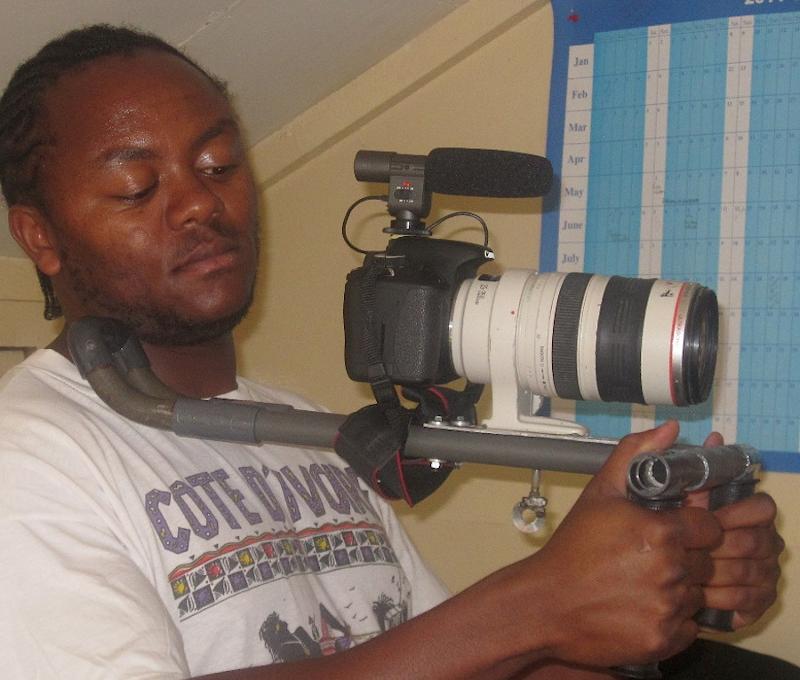 Robert Ntawuasa asks... Care to Donate now? (Robert is our IT man, field researcher, photographer and filmmaker) |
|
Anti-Poaching and
Who is Doing What?
| | |
We have been asked recently which organization should be funded for anti-poaching in Amboseli?
First it's important to know that anti-poaching is not just about uniforms, boots, guns and patrol vehicles. It's also about working in a community.
The Amboseli Trust for Elephants, is fighting elephant poaching in indirect but important ways such as:
- working closely with the community to encourage it not to help poachers who try to come in from outside;
- rewarding good conservation practices in the ecosystem through university and secondary school scholarships and support to such activities as the Maasai Olympics;
- hiring people from the community as researchers, camp workers, scouts and informers;
- funding a long-running consola-tion scheme that pays for livestock killed by elephants so that there is no retaliatory spearing of elephants;
- training community scouts about elephants; and
- Soila Sayialel, our Deputy Director, sits on the boards of several grass-roots conservation organizations that work tirelessly to stop poaching.
ATE also plays an important role by simply being the eyes and ears on the ground.
We know all the elephants individually, and our team is out monitoring on a daily basis. When an elephant is wounded or killed we know.
If elephants become agitated and start running away from vehicles, we know that poachers are around and we can alert the patrols.
So our answer is: support ATE and you will be supporting anti-poaching.
Kenya lost 85% of its elephants due to poaching in a 15-year period from 1974 to 1989. In that same period the Amboseli population grew by 25% -- the only place where there was an increase. Why? Because a few researchers were on the ground constantly aware of what was happening and the Maasai people surrounding the Park were intolerant of poachers.
We have to work on many fronts to stop the slaughter, so please do help us stay in the field to do our kind of anti-poaching.
|
|
Removing Tusks?
| 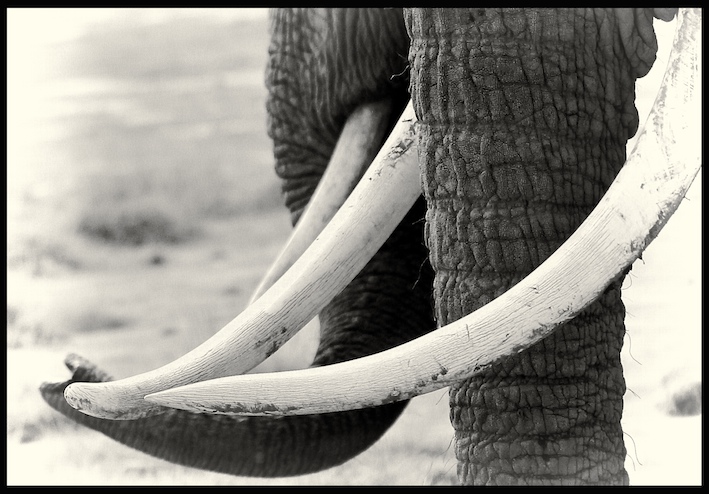 | |
Another question we are often asked: why not saw off the tusks of elephants in order to save them from poachers?
There are many compelling reasons why it would not be practical, economical or ethical to immobilize every elephant to cut off its tusks.
- It's logistically difficult. Many elephants live in remote areas, hard to reach and work in. Darting is difficult and dangerous to both the elephants and the veterinarian team.
- It's numerically impossible. In Kenya alone there are 37,000 elephants. Both male and female African elephants over 2 1/2 years old have tusks, say 30,000 individuals with some ivory. Even if you could immobilise at the world-record rate of 5 a day (which ATE did once in 2011!), the operation would take some 15 years of full-time work. And by that time, the first elephant would have re-grown meter-long tusks!
- It's expensive. Even if teams of vets and rangers could reach all the elephants, the cost of the exercise would be prohibitive. Among other things the drug is costly and difficult to obtain.
- It would be painful. There is a nerve that runs well down the length of an elephant's tusk. Cutting the tusk off would be painful, similar to you breaking a tooth. Remember that an elephant tusk is a modified incisor. Cutting beyond the nerve would still leave a third of the tusk in place.
- Finally, elephants need their tusks for feeding and digging and for defending themselves and their calves from predators.
|
|
Update on Rescued Calves
|
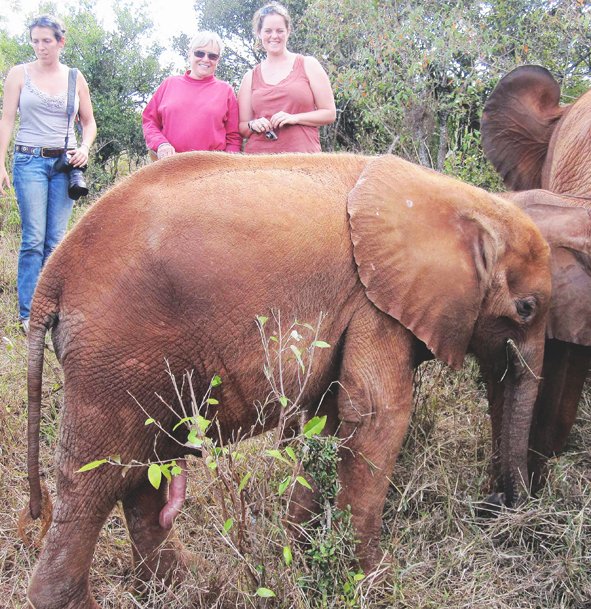 | |
Faraja and friends (Tal Manor of DSWT, Cynthia, Vicki).
|
| |
Over the last few months the ATE team has rescued several calves from a variety of perilous situations.
Three calves fell into man-made wells outside the Park. In two cases the mother was present, and the team was able to safely return the calves to the mothers. These calves were: a WB calf whose mother we couldn't identify in the dark and the daughter of Zombe of the ZA family (this was the dramatic rescue that was filmed and went viral on our YouTube channel.). A fourth calf was rescued from a natural waterhole and returned to its mother, Zahava of the ZCs. Both Zombe and Zahava's calves have been seen recently with their families and both were in fine shape.
One other calf who was stuck in a well was completely on his own when he was rescued and therefore we could not return him to his family. We named him Lemoyian for the place where he was found and sent him to the David Sheldrick Wildlife Trust orphanage in Nairobi where he is doing well.
 | |
Lemoyian out with the older calves
|
Three additional calves had to be rescued because their mothers had died and all were sent to the David Sheldrick Wildlife Trust (DSWT) orphanage.
The first was Faraja whose mother Fenella disappeared. He was only eight months old and could not survive without milk. The second was Quanza whose mother Qumquat was killed by poachers along with her two older daughters. Quanza was found huddled against one of her dead sisters. See our report of this tragic event here. The third was Tikondo whose mother Tatabamba died of unknown causes in the Kimana Sanctuary. Faraja, Lemoyian and Quanza have adjusted well at the orphanage making friends with some of the other orphans. Unfortunately, Tikondo, who was only three weeks old, didn't make it. His condition was poor when he was rescued and he never recovered. The DSWT did all they could to save him and we are so thankful that they are able to take in these orphans.
|
|
Wish List
| |
First we want to thank three donors who very generously sent digital Canon Rebel cameras each with two Canon lenses. They are perfect for our needs. Soila and Katito now both have excellent equipment for updating the ID photos for the elephants.
Jill Eklof and Mary Beth Napoli sent one camera and Beth Klemick sent the other. Thank you so much for helping us in this way.
We still need a pair of binoculars for Robert, who is doing more and more field work these days. He needs a good pair, preferably Zeiss or Leica 10x40s, but any good binoculars will do.
We hope there is a donor out there who can help us.
|
|
Give a Gift that Lives Forever
| |
Include ATE in your bequest and estate planning. For a brochure on how to do that, contact Betsy Swart in our US office at: eswart@elephanttrust.org.
|
|
YouTube Chanel
| | The Amboseli Trust for Elephants has its own channel on YouTube. Check out our latest videos here. |
|
Archive of Past Newsletters
|
Previous issues of the ATE newsletter can be found on our website: |
|
|
News from the Amboseli Trust for Elephants
November-December 2012
|
Greetings!
The year is coming to a close and we at ATE have some reasons to be cheerful but many reasons not to be. The good news is that the ecological conditions in the ecosystem are favorable for the elephants. There has been rain all around if not much in the Park itself, but the rain outside is providing more than enough food.
On a happy note the baby boom continued right into November. To date we have recorded 230 calves born since October 12, 2011. I think every female who could have had a calf had one and all but six of these calves survived. Now the young females just reaching maturity are giving the big bulls something to be excited about.
We also had reason to celebrate when the Amboseli Elephant Research Project reached its 40th birthday. See the story and photos below of the party.
On the negative side, we are ending the year with great concern for the very future of elephants. The illegal ivory trade is totally out of control. Just a few days ago another huge shipment was intercepted, this time in Malaysia. They found 1500 tusks representing at least 750 dead elephants and that doesn't take into account all the young calves who died when their mothers did. It is a rate of killing that cannot be sustained.
We are doing everything we can but I have to say we are frightened and discouraged. However, we must not give up. We will continue fighting for elephants.
With hope for the future,
Cynthia Moss
DirectorAmboseli Trust for Elephants
|
|
|
Holiday Special for Naming an Elephant Calf
We want to remind you that the Amboseli Trust for Elephants offers a unique opportunity for a donor to give name an elephant calf. The program has been in existence since 1988 and it works like this:
- There are 58 families in Amboseli. Each family has a letter of the alphabet, and all the individuals in the family have names starting with the family letter.
- We generally don't name calves until they are four years old. Before that the calf has a code name based on its mother's name and year of birth, but for the naming program we will name calves as young as 18 months to two years. With the current baby boom we now have more than 400 unnamed calves so we really need your help.
- Since most of the common names have been used, although not all of them, it is best to provide three possible names. We suggest using a special nickname or a family name or an unusual spelling of a name.
- No other calf will have your chosen name. It's a very exclusive program, unlike an adoption program in which hundreds of people might adopt the same elephant or whale or whatever. Your name will go down in the research project records and be used forever: this is why the name has to be unique.
- The namer will receive recent photos of the calf, its mother and family, a naming certificate, as well as a description and history of the calf's family. The namer will also get periodic updates over the years.
To name an Amboseli elephant we ask for a donation of $2,500,
but we're having a holiday special for only $2,000.
If you are interested please respond to info@elephanttrust.org or write to Betsy Swart at the Newburyport address provided below, or if you want to give a wonderful Christmas present to someone this year, phone Betsy Swart at +1 508-783-8308.
|
 |
|
40th Anniversary of AERP
It is 40 years since Harvey Croze and Cynthia Moss started the Amboseli Elephant Research Project on September 1, 1972 making it by far the longest, continuously running research on elephants in the world and nearly the longest for any mammal.
Proud of this accomplishment, we decided to have a party to mark the 40 years. The Kenya Wildlife Service very generously offered to co-host an event. After much discussion and planning we decided to have two parties: one in Nairobi and one in Amboseli. The first was held on November 23 at in the Nairobi National Park, appropriately at the Ivory Burning site. For this one we invited KWS directors, Amboseli wardens, KWS scientists, research and conservation colleagues, NGOs and friends of the project. It was a great success with more than 100 people attending.
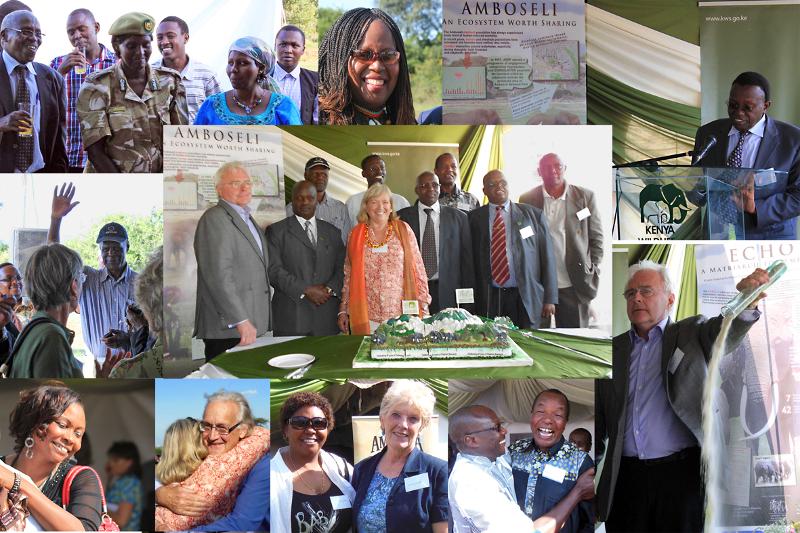 | |
Clockwise from upper left: Ex-warden Eden Kalla, KWS's Ann Kahihia, ATE's Purity Waweru; M.C. Pat Awori; KWS Board Chairman, David Mwiraria; Harvey shows the worthlessness of ivory; ex-Director Nehemiah Rotich and and ex-warden Joe Kioko; Soila Sayialel and Betsy Swart; Cynthia and Iain Douglas-Hamilton; Katito Sayialel; Walter Njuguna, warden in 1974. Center: Harvey and Cynthia with former Amboseli wardens (Wilson Korir, Walter Njuguna, Tuqa Jirmo, Eden Kalla, Joe Kioko, Michael Kipkeu and Naftali Kio; and present warden Richard Chepkwony)
|
The second party for the local KWS staff, lodges and the Maasai community will be held on December 19; we'll post photos of that event online.
|
Five Families: Requirements and Risks
Five GSM*-collared females -- Ida, Lobelia, Vicky, Willow and Maureen of the IB (dark blue on map below), LB (purple), VA (green), WA (light blue) and MB (red) families, respectively -- have been providing excellent hourly data showing the importance of wildlife corridors into the ecosystem. See links to the video here and the article in the ATE Newsletter here.
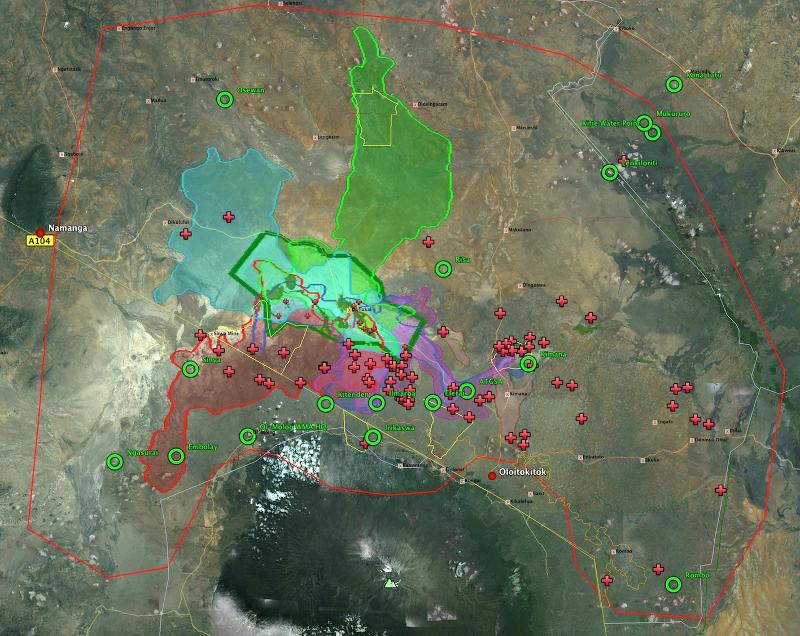 | |
Five families facing the ecosystem
|
A new Google Earth tool lets us display the data right from the elephants, through Ntauwasa's computer, onto Google Earth. Have a browse and tell us what you think.
The map shows the distribution of the five families from July 2011 to November 2012. In the 15 month period each family demonstrated clearly the importance of tolerance to their presence by the Maasai community which lives around the small 392 kmē Amboseli National Park (green boundary): in their yearly wandering for a variety of food, Amboseli elephants may cover nearly 10,000 kmē (red outline shows the approximate extent of the ecosystem).
The data show the extent to which the five families range into the ecosystem. Although each family tends to venture out into its own preferred direction and region, they all share the common core of swamps in the national park.
The red crosses show the locations of elephants speared or shot in the Amboseli ecosystem since 2008. The total number of found carcasses was 75. Only a few of those died from natural or unknown causes. (The 11 elephants that died inside the park either died naturally or had been wounded outside and returned to the park to die.)
It is clear that elephants are at increasing risk outside of the protection of the Park--a growing risk that is driven by the demand for ivory in the markets of the Far East.
But the good news: Since 2010 the Big Life Foundation in partnership with the Maasailand Preservation Trust has mounted a force of 250 rangers in 21 outposts (green circles) with 14 vehicles to augment and compliment the Kenya Wildlife Service in anti-poaching activities. Over 600 arrests have been made and nearly 2,000 weapons confiscated.
*GSM - Global System for Mobile communications, essentially the mobile phone network.
|
The History of the SA Family
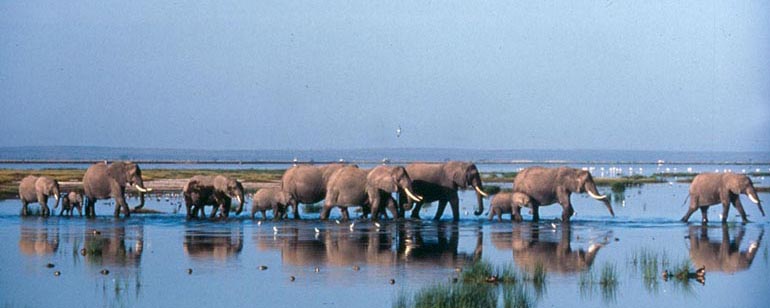 The SA family was the third group sighted and photographed on the very first day of the Amboseli elephant study on September 1, 1972. The first group was designated the AAs; the second the BAs; and the third should have been the CAs, but it ended up being the SAs. The matriarch of this third group was originally called 'Cynthia' by my co-worker Harvey Croze, but for some convoluted reason which I can't remember today the other adult females were given names starting with 'S', Sandy and Shirley, and thus it became the SA family. Eventually, in order to conform with the other names and because I always felt it was not fitting to have an elephant named after me, at least not in the Amboseli population, I changed Cynthia's name to Sabina. Actually I needn't have worried too much, because poor Cynthia/Sabina did not live for that much longer. During the part-time phase of the study I saw her three times, the last occasion on New Year's Day 1974. After that she disappeared. Sabina was a wonderful female with huge, extremely smooth ears without a nick or hole in them. She was much older than anyone else in the family and I therefore guessed that she was the mother and probably the grandmother of some of the younger females. The SA family turned out to be very tolerant of vehicles and for this reason I was able to get a good idea of who belonged in the group early on in the study. In fact on that New Year's Day I was able to sex the individuals, make good age estimates, and take photos of the family. There were "9 exact" in the group, as my notes read, and the structure looked like this:
Adult female - Sabina
2-3 year male calf
6-8 year male calf
Adult female - Sandy
4-5 year female calf
Adolescent female, 10-12 years old - Shirley
8-10 year old female with one right tusk
8-10 year old male
7-8 year old female calf
To read the whole history of the SA family click here. |
|
Amboseli Book Chapter Summary: 7. Patterns of Occupancy in Time & Space
In Chapter 7, Patterns of Occupancy in Time and Space Harvey Croze and Cynthia Moss (with a contribution by Iain Douglas-Hamilton on radio tracking) show how elephants have occupied the Amboseli ecosystem over time, including changes over the years in moving to and from Amboseli National Park, and ways that different family and groups of families share space within Amboseli. These analyses were made possible by individual recognition within more than 58 families. The chapter also explores which corridors are needed to provide elephants access in and out of the protected areas.
- The total range of the Amboseli elephants is approximately 11,500 km2 (4,400mi2), nearly 30 times greater than the area of the national park (392 km2, 150mi2) in the centre of their range.
- The Tanzanian portion comprises approx. 25% of the total range.
The elephants have changed seasonal occupancy of the national park over time. In the early 1970s, they concentrated in the basin during the dry season (May to October) and moved off into the surrounding ecosystem as soon as the rains began in the wet season (November to April). With the removal of cattle from the park and a period of higher rainfall in the late 1970s, elephants started to occupy the central areas during wet months as well, often reversing the original pattern by moving out in the dry season. Food abundance and variety, good and bad rainfall years, and encounters with people and cattle are the main attraction and repulsion factors.
- Elephants aggregate in large groups (up to 300 strong) in areas with high food availability.
- In the dry season and in dry years, elephants use the swamps in small groups, and overall fewer elephants are seen in the national park, the so-called "August Vacation".
- The increase of protected and patrolled community wildlife concessions in the ecosystem dispersal areas over the past two decades has created areas of attraction and refuge allowing the elephants to spend more dry season time safely out of the ecosystem core.
- Since 2008, however, with a surge of poaching, there has been an rising frequency of illegal killings that is sure to reinforce a major hazard to dispersal.
Radio collaring of family groups in the 1970s and 1980s, pioneer satellite collaring of bulls in the 1990s, together with the expert observational knowledge of the AERP research team, plus recent collaring efforts is clearly defining the vital need for corridors and easements for elephants and other wildlife outside of the national park.
Some families tend to associate with each other in one part of the core range more often than other parts, concentrating in four distinct 'neighbourhoods'. The neighbourhood boundaries are not rigid: some are shared seasonally by related families. Some families have shifted neighbourhoods altogether over the years, probably repulsed by increased human presence at cattle watering spots on the park boundary.
Bulls tend to lead a life of their own. After leaving their birth families at puberty, they linger at the edges of the population, on their own or hanging out in male groups - except during periods of musth when they actively stomp through family groups looking for females in oestrous.
Daily and seasonal distribution patterns are determined primarily by availability of forage and water. But elephants also exhibit complex group fusion and fission, and subtle shifts in distribution that can best be explained by personal relationships between individual adult females, matriarchs in particular.
|
|
|
No one needs ivory, no one is addicted to ivory, and no one will be saved from a disease by buying ivory. Only elephants need ivory. How can we get this message across to the Chinese, most of whom don't even realize an elephant has to die in order for people to get its tusks? We must try to change their attitude.
Let us hope that there is breakthrough in 2013. We are wishing for a Happy, Peaceful and Safe New Year for all.
Cynthia Moss
Amboseli Trust for Elephants |
|
|